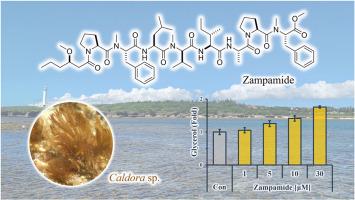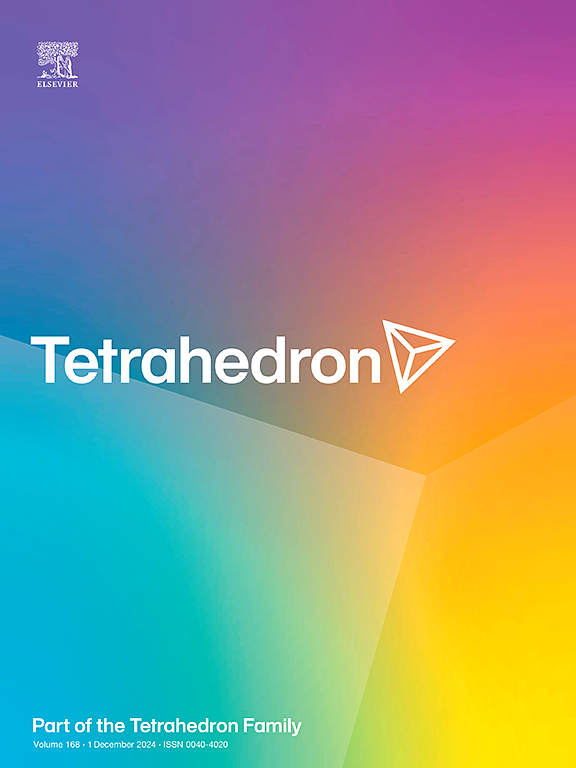Zampamide: A lipopeptide isolated from Caldora sp. marine cyanobacterium
IF 2.2
3区 化学
Q2 CHEMISTRY, ORGANIC
引用次数: 0
Abstract
Overweight and obesity are pathological conditions characterized by the accumulation of excessive fat. Adipokines, which are secreted by hypertrophied adipocytes, are known to increase the risk of various diseases. Therefore, identifying compounds that promote lipolysis in adipocytes is a promising way to prevent hypertrophy of these cells. Although numerous bioactive compounds have been isolated from marine cyanobacteria, reports on compounds exhibiting such activity remain limited. In this study, we report the discovery of zampamide (1), a linear lipopeptide that stimulates lipolysis in 3T3-L1 adipocytes. It was isolated from a marine cyanobacterium of the genus Caldora collected in Okinawa, Japan. The planar structure of 1 was elucidated primarily using two-dimensional NMR and mass spectrometry. The absolute configurations of the amino acid residues in 1 were determined after acid hydrolysis, followed by Marfey's analysis of the resulting hydrolysates. Additionally, the absolute configuration of the fatty acid moiety was determined by derivatization. Zampamide (1) increased the amount of free glycerol in a dose-dependent manner, demonstrating its lipolysis-promoting activity. These findings suggest that marine cyanobacteria are a valuable source of novel lipolysis-promoting agents for obese and overweight patients.

Zampamide:一种从Caldora sp.海洋蓝藻中分离出来的脂肽
超重和肥胖是一种以过度脂肪积累为特征的病理状况。脂肪因子是由肥大的脂肪细胞分泌的,已知会增加各种疾病的风险。因此,鉴定促进脂肪细胞脂肪分解的化合物是防止这些细胞肥大的一种有希望的方法。虽然从海洋蓝藻中分离出了许多生物活性化合物,但有关化合物表现出这种活性的报道仍然有限。在这项研究中,我们报道了zampamide(1)的发现,zampamide是一种线性脂肽,可以刺激3T3-L1脂肪细胞的脂肪分解。它是从日本冲绳收集的Caldora属海洋蓝藻中分离出来的。1的平面结构主要通过二维核磁共振和质谱分析得到。在酸水解后确定1中氨基酸残基的绝对构型,然后对得到的水解产物进行Marfey分析。此外,脂肪酸部分的绝对构型由衍生化确定。Zampamide(1)以剂量依赖的方式增加游离甘油的量,显示其促进脂肪分解的活性。这些发现表明,海洋蓝藻是肥胖和超重患者的新型促进脂肪溶解剂的宝贵来源。
本文章由计算机程序翻译,如有差异,请以英文原文为准。
求助全文
约1分钟内获得全文
求助全文
来源期刊

Tetrahedron
化学-有机化学
CiteScore
3.90
自引率
4.80%
发文量
439
审稿时长
34 days
期刊介绍:
Tetrahedron publishes full accounts of research having outstanding significance in the broad field of organic chemistry and its related disciplines, such as organic materials and bio-organic chemistry.
Regular papers in Tetrahedron are expected to represent detailed accounts of an original study having substantially greater scope and details than that found in a communication, as published in Tetrahedron Letters.
Tetrahedron also publishes thematic collections of papers as special issues and ''Reports'', commissioned in-depth reviews providing a comprehensive overview of a research area.
 求助内容:
求助内容: 应助结果提醒方式:
应助结果提醒方式:


